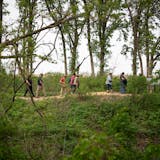Phenology: A branch of science dealing with relations between climate and periodic biological phenomena, such as bird migration or plant flowering.
AKELEY, MINN. – Friday is Earth Day, and few people study the Earth as closely as Dallas Hudson.
A phenologist by vocation and avocation, Hudson, 51, an employee of the U.S. Geological Survey, years ago began to detail his observations about the ever-changing seasons and their effects on plants and animals.
Elm and red maple trees, for example, are just now flowering near his northern Minnesota home, while spring peepers and tree frogs are singing and white-throated sparrows and yellow-rumped warblers are migrating.
Additionally, marsh marigolds, hepaticas and coltsfoot are blossoming, while variegated meadowhawks — a type of dragonfly — are passing through en route to points north.
"For some time, I would notice these and other changes that occur with the seasons," Hudson said, "but I didn't write them down. Finally, I started a journal to document what I saw. Today, I guess you'd call it an obsession."
Prepared anew this spring to detail seasonal changes, Hudson a few days ago fired up a small outboard motor that hung from the transom of a well-used johnboat. He and two assistants, both students at Bemidji State University, were headed onto a 160-acre lake to check nets they had set to catch bluegills, crappies, northern pike, largemouth bass and other fish.
One of four property owners on the lake, Hudson has been researching the small body of water since 2009, when he was given a permit by the Minnesota Department of Natural Resources to set nets in it.
![Three weeks ago, Octavio Rodriguez switched from making transmission parts to casting parts for hospital bed brake assemblies at Twin City Die Castings. ] GLEN STUBBE • glen.stubbe@startribune.com Thursday, April 9, 2020 How employee-owned Twin City Die Casting, which just laid off 40 production workers of its 250 employees in what was supposed to be a good year, is trying to accelerate its pivot to growing medical parts business for ventilators, hospital beds, etc as it copes with instan](https://arc.stimg.co/startribunemedia/WNZYKGTZ5IYMUCO3KI5TR3N7WI.jpg?&w=80&ar=1:1&fit=crop)
djoles@startribune.com As boaters flock to Minnesota lakes and rivers this holiday weekend for the unofficial kick-off to the boating season, they'll face more inspections in and out of the water as local cities and counties ramp up their work to stop the spread of invasive species. Across the metro, more boat accesses will be staffed by watercraft inspectors thanks to $10 million funneled to county government programs this year, up from $4.5 million the state allocated last year. ORG XMIT: MIN1505222156290209 ORG XMIT: MIN1506021218440580](https://arc.stimg.co/startribunemedia/34QSKO44B2XKVNUZCO5SLJQSLY.jpg?&w=80&ar=1:1&fit=crop)

